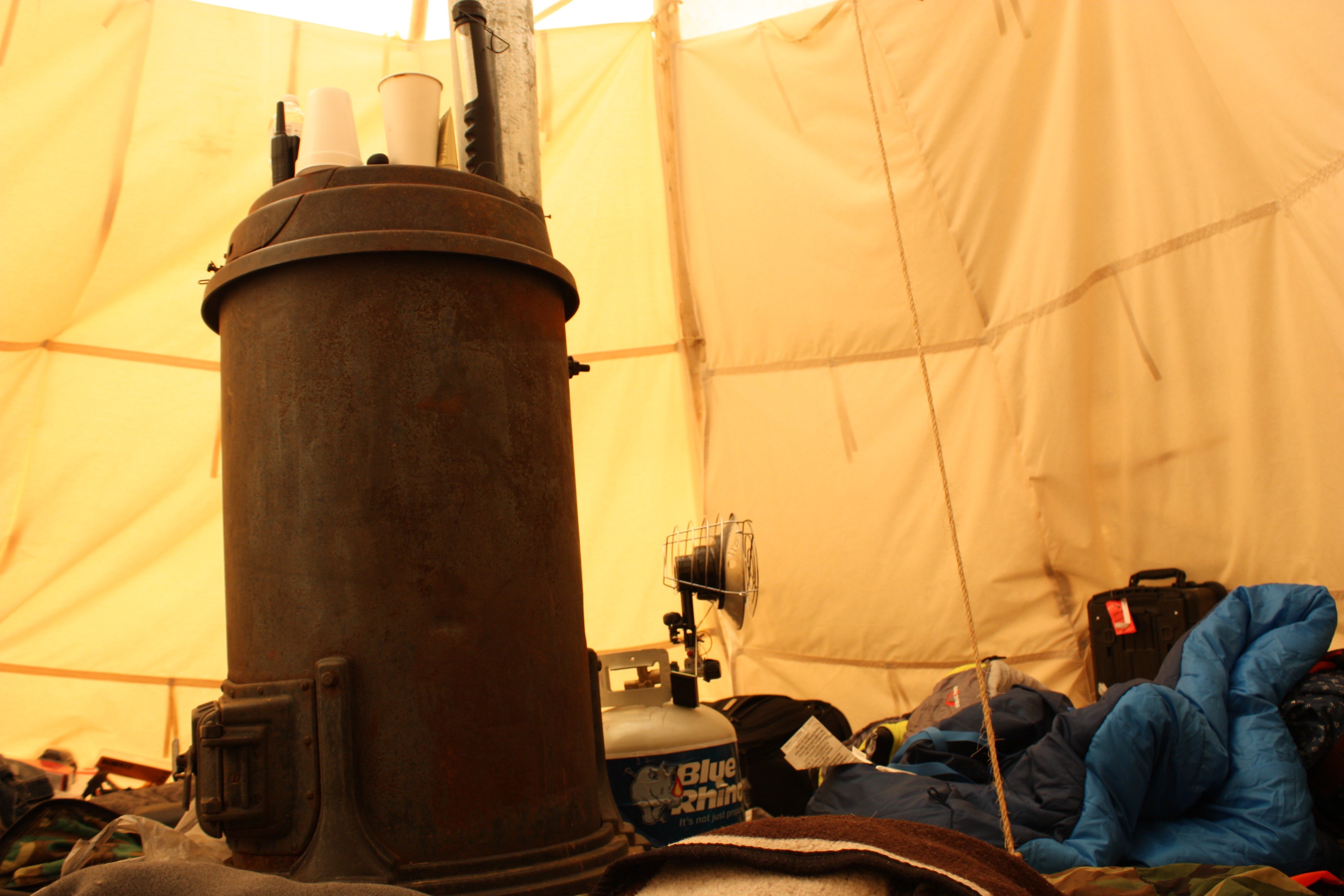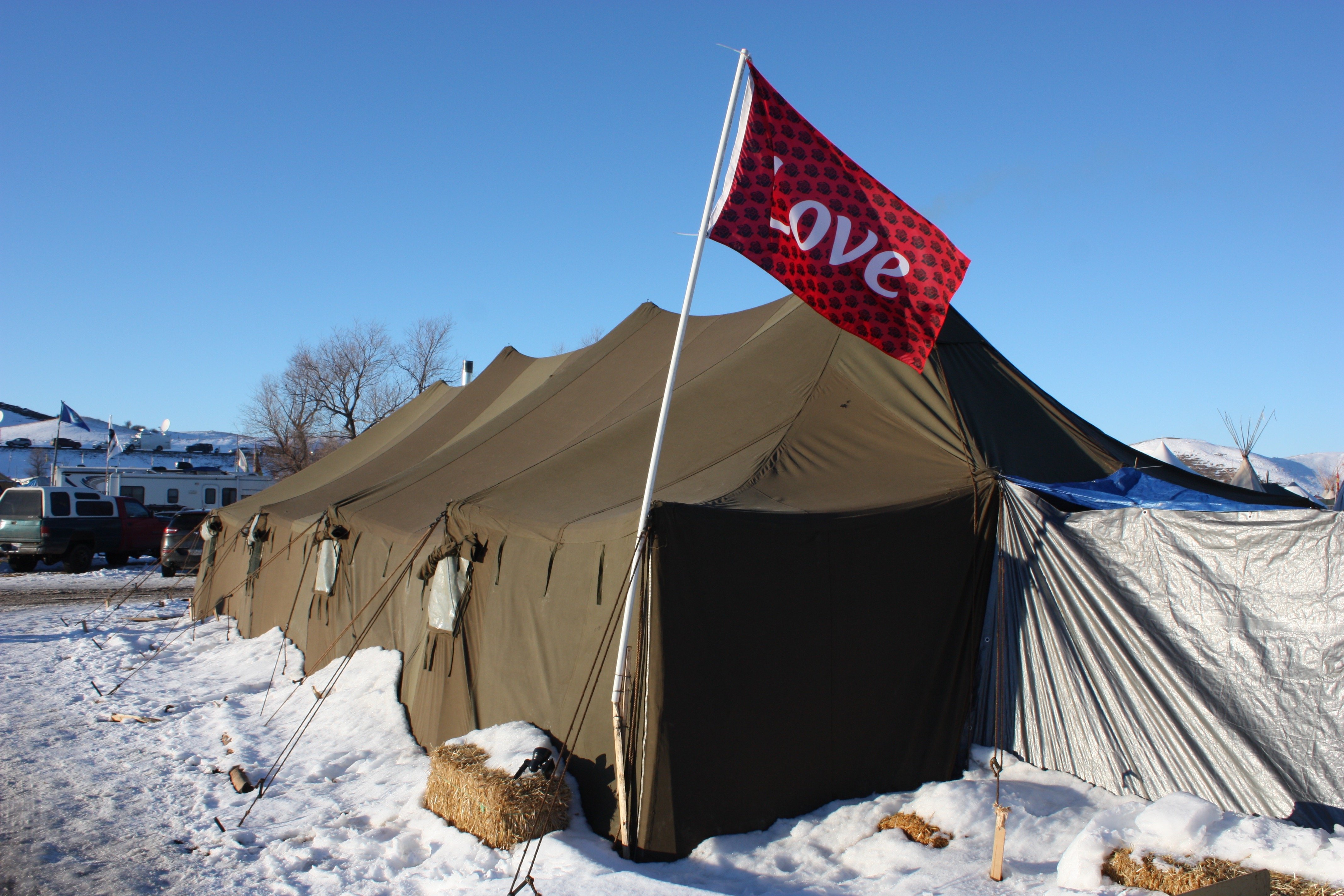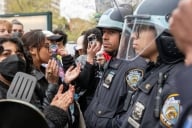You have /5 articles left.
Sign up for a free account or log in.
Oceti Sakowin (later called Oceti Oyate) was the main camp at Standing Rock. On February 23, 2017, it was cleared by law enforcement from several states and the North Dakota National Guard. Across the Cannonball River was Sacred Stone, the first camp in the movement, which was closed March 1, by the Bureau of Indian Affairs and law enforcement officers said to be national park rangers.
(Could the National Park Service be as split as the rest of the country, with interpretive rangers alt-tweeting “resist” while law-enforcement colleagues apply political force? Parks law enforcement have been staying at the tribal casino hotel and pull long gun cases on wheels like luggage through the halls....)
This post is one of a series on the veterans’ event that took place in early December at Standing Rock. The event contributed to the decision by the Army Corps of Engineers to rescind the easement for the Dakota Access Pipeline, meant to pass under the Missouri River a mile from the Standing Rock Sioux reservation. The rescission on December 4 was celebrated as a victory. Donald Trump effectively reversed it January 24, and oil will flow, the company says, by April 1.
Last Friday was the Native Nations Rise march in Washington, DC, along with several days of political meetings, church events, and concerts. Standing Rock activists played a central role.
***
It was cold in the astronomical twilight before dawn on Saturday, December 3. The flap to the tipi had blown open during our brief sleep, and wind swirled over the bodies and detritus of cold-weather camping inside. The tiny burner on the propane tank had gone out, and a cast-iron stove made for the US Army nearly a century earlier sat useless as a hernia in the center of the floor. 
It had been a hard couple of days of travel. Tommy, another vet, lay in his army sleeping bag in front of the open door, comfortable as a Viking in bilgewater. Gaff was still and silent in the bag next to mine. Gaff’s a killer and an undergrad at the New School, afraid of only one thing in this life, he says—the SPG-9, a Russian 73mm recoilless rifle he saw in use in Afghanistan—and he lay smiling sweetly in sleep.
The sky lightened through the open door and out the top of the poles as the sounds of camp rose—a car engine, generator racket, shouts, faraway singing and a drum. Heather, our Oglala host, had come in only recently from all-night medic rounds and had fallen into exhausted sleep. I didn’t want to disturb her, but finally there was no escaping my problem. I fought out of my bag and thrashed pulling on freezing jeans, freezing Polartec shirt, freezing quilted coveralls, freezing insulated boots, and my freezing winter coat, which I hadn’t needed in five years. I struggled to my feet, nearly fell on Gaff, stepped over Tommy and squatted painfully in the same motion, and crawled out the door into the morning.
Oceti was as striking under the winter sun as it was sublime in darkness—a village of large white tipis, army tents in OD green and desert sand, yurts, a canvas longhouse, cars, trucks, buses, woodpiles and cutting yards, work sites with wall-framing underway, the smoke of wood fires, a muddy central avenue lined with flags snapping in the sharp breath of the Plains. There were perhaps 5,000 people on the multi-acre field between Cantapeta Creek to the north and the Cannonball River to the south, with another 2,000 to 4,000 veterans and other allies on the way.
Later, foes would claim the camp itself was an environmental hazard, since the field turned out to be a floodplain, and anything on it could end up in the Missouri at spring melt. They’d say water protectors, as they wished to be called, were hypocrites for claiming to want to save the river from contamination by oil. But during the first week of December, flooding wasn’t being discussed at all—I’d venture that most had never been told it was a possibility—and responsible infrastructure seemed in place.
 Porta-potties, my need and reason for rising, were placed strategically around camp, and compost toilets were being built, thanks to actress Patricia Arquette. Giant roll-off dumpsters were used for trash collection. (Unlike Paris, Oceti didn’t seem to have so much as a pile of dog crap lying around; any clutter was stuff waiting to get used.) A few solar arrays had been brought in by small alternative-energy companies. Seven central kitchens kept individual cooking fires to a minimum, and tent-dwellers without heat could keep warm and safe in the kitchens and in two connected geodesic domes used as a community center. People checked on each other, and Heather and her fellow medics and security went around all day, every day, asking how everyone was doing. Security kept the peace and safety, and it's notable that no one died in 10 months in the occupation--not from conflict in or out of camp, from drugs or alcohol, from traffic accidents, or from harsh weather.
Porta-potties, my need and reason for rising, were placed strategically around camp, and compost toilets were being built, thanks to actress Patricia Arquette. Giant roll-off dumpsters were used for trash collection. (Unlike Paris, Oceti didn’t seem to have so much as a pile of dog crap lying around; any clutter was stuff waiting to get used.) A few solar arrays had been brought in by small alternative-energy companies. Seven central kitchens kept individual cooking fires to a minimum, and tent-dwellers without heat could keep warm and safe in the kitchens and in two connected geodesic domes used as a community center. People checked on each other, and Heather and her fellow medics and security went around all day, every day, asking how everyone was doing. Security kept the peace and safety, and it's notable that no one died in 10 months in the occupation--not from conflict in or out of camp, from drugs or alcohol, from traffic accidents, or from harsh weather.
A sense of common purpose in protest had been deepened by the weather and (for some) the imminent arrival of thousands of reinforcements, many of them combat-trained, young, and fit. Optimism said the pipeline would be stopped, and the camp would become a historical landmark in the struggle for human rights, as well as (eventually) a model of sustainable living. Even non-natives said they felt the spirituality of the sacred fires, sweat lodges, and Native prayer and rites.
But there were tensions, before and after the vets came. Oceti Sakowin was 100% dependent on donations, from food and water to firewood and propane. Chase Iron Eyes, a Standing Rock Sioux member, lawyer, and former candidate for Congress, said he provided 80% of the firewood and propane, through his organization Last Real Indians. So many other donations, such as sleeping bags and medical supplies, poured in by mail, FedEx, and UPS, that volunteer crews had to be formed to get them from town before they were sent back to senders. Flyers on toilet doors listed who to call to join the effort.
Donations weren’t just things, such as gas masks and trailers filled with frozen meat. The official Veterans for Standing Rock page at GoFundMe had raised $1,155,760 from 25,989 donors in little more than a month. (As of today, GoFundMe alone lists 4,026 Standing Rock-related funding projects.) With the camp standing for sovereignty, traditional ways, and sustainability, reliance on and acceptance of outside help made it vulnerable to political rhetoric.
Another tension was the factions, even within the Native community, which valued different means to the same end. Many of the elders, matriarchs, and headsmen stressed peace and prayer, but Red Warrior Society (“Indigenous Resistance to Colonialism, Resource Extraction, and Genocide”), eg, favored “direct actions” that were not prayer circles, and many of the vets who came to Standing Rock expected to take part in those.
Bound up in the Native Americans' appreciation for allies were fears that culturally-clueless non-natives would take over the movement with dreams of being white saviors, re-enacting colonialism in the process. “This isn’t Dances with Wolves, and you aren’t Kevin Costner,” a Native vet says in an orientation video I saw only months after Veterans Stand.
 The camp was large enough that it took maybe 45 minutes to walk the circumference. Dirt roads led me back to the north guard shack on State Highway 1806, the western boundary of camp. A small bridge a quarter-mile north had been blockaded by police to keep people away from the drill pad and, many believed, to punish the tribe economically. In fact there were many complaints about the closed bridge—by whites from Bismarck, who wanted to get more directly to points south, including the tribal casino; by Standing Rock tribal leadership, who wanted to give white folks the chance to surrender their money; and by Native residents of the Cannon Ball district, who could only get to Bismarck businesses by driving way around, and whose sick and elderly were put in danger, they said, by poor access for emergency services.
The camp was large enough that it took maybe 45 minutes to walk the circumference. Dirt roads led me back to the north guard shack on State Highway 1806, the western boundary of camp. A small bridge a quarter-mile north had been blockaded by police to keep people away from the drill pad and, many believed, to punish the tribe economically. In fact there were many complaints about the closed bridge—by whites from Bismarck, who wanted to get more directly to points south, including the tribal casino; by Standing Rock tribal leadership, who wanted to give white folks the chance to surrender their money; and by Native residents of the Cannon Ball district, who could only get to Bismarck businesses by driving way around, and whose sick and elderly were put in danger, they said, by poor access for emergency services.
A left just before the guard shack led through rows of tents and cars along the two-lane highway, past a horse pen, empty now, then up the slippery slope of the only terrain feature in camp. For months it had been called Facebook Hill for its homemade cell tower, but about the time we got there it had, significantly, been renamed Media Hill. Press and Legal tents were on top, amid other structures and parked cars, including a van that served as broadcasting studio for Spirit Resistance Radio. Someone had painted a large sign that read, “Chemtrails cause climate change,” and a photo op at the highest point offered a “Water is Life” banner, a snowman, and a vista of camp with militarized law enforcement in the distance.
The panorama of winter resistance looked like any place—or time—except contemporary America, and residents struggled to describe it to newcomers and the outside world. It looked like a refugee camp abroad, some said, or a post-apocalyptic settlement on the edge of what was left of America’s wealth, or a postmodern jumble of 19th, 20th, and 21st century images. A yellow DAPL helicopter was on orbit over the tipis, while a drone whirred far beneath two circling hawks. (One of these drones, piloted by Native media company Digital Smoke Signals, had helped put the lie to Morton County Sheriff’s Department claims that water cannons weren’t used on people in 26-degree weather two weeks earlier.)
The Missouri River ran somewhere to the east, and its big freshwater smell was on the breeze. The surrounding hills were shaped naturally but looked much like manmade mounds at Cahokia; both served as sacred burial sites, which was one of the main objections to the pipeline. Sacred Stone founder LaDonna Brave Bull Allard, who has deep ties to white-Native conflict, says her father and son are buried nearby. An indigenous journalist said human remains had been found when the state cut the highway along Media Hill.
Visible on hills to the north were armored vehicles, radio masts, razor wire, and observant men in modern armor, carrying weapons. In a sadistic, criminally-stupid show of force, Stinger Missile systems would be placed on those hills on January 16. (Ask yourself what it means, even symbolically, for military weaponry of that kind to be deployed against American citizens.) North of the police line was a two-mile corridor, 150-feet wide, that DAPL had bulldozed on September 3, which the tribe specifically decried as a “desecration of burial grounds.”
A press pass was required to take photos in camp or even ask people questions, and the media coordinator and others would tell us that anyone caught without a pass faced expulsion from camp and possible rough treatment. For now, someone standing guard outside the closed media tent said there would be a mandatory press orientation—they wanted the story told as they wished it to be heard—but when, he didn’t know. It was clear from the start the staff was both overwhelmed and unprepared for the mainstream and “independent” media (many of whom had no credentials) descending to watch the veterans’ event play out. Over the next two days I’d walk up and down icy Media Hill six times.
Attitudes toward media were deeply ambivalent. Many in camp were enraged by a perceived lack of mainstream coverage, which they saw as existential threat if not conspiracy. Yet the media tent gave out press passes slowly, sometimes leaving 20 people standing in the cold and wind for hours. The Al Jazeera stringers traveling with us missed the start of one orientation by seconds and were told to go away and come back later, but when, no one knew. Other times passes were issued to women who had just walked up, because matriarchy was the Native way, a white media coordinator said. Some believed only Natives should speak of an event by and for Natives, even as there were worries that 80% of the people in camp were non-Native. Red Warrior, when asked if they would like to make someone available for an oral history, told me, “thank you, but we will tell our own story. someday.”
On top of suspicion and confusion, media staff and action organizers told us police would target those with press passes, so we should hide them in our clothing if we went to “the front.” We must, however, be ready to produce them to anyone from camp on demand. And despite (social) media playing the key role in garnering support and swelling numbers—especially videos of the water cannon skirmishes, which seemed especially perverse because they happened during Thanksgiving week, of all holidays—we weren’t to take photos during actions of protestors’ faces, as they might be used by police later. A white photographer in the Getty stable, famous for his work in Ferguson, was living in his car at Standing Rock and looked more haggard each day. He told me later as we stood in a crowd around the sacred fire: “A press pass here is like the Star of David.”
Now an “independent filmmaker” standing forlornly on the hill outside the Media tent said that because there were many factions and no clear leadership in camp; because roles were ill-defined; because the camp was made of transients; and because information was jealously guarded, gossip spread easily and created fear and anger. Chief among these were rumors of police infiltrators and DAPL agents provocateurs. I thought he was headed for how journalists and new vets might be suspected of such treachery, and perhaps rightfully so. Instead he told me police forces could be crouched even now by the river, peering over the verge at camp, waiting for an infiltrator’s signal to sweep through with brutal cruelty. Anyone who survived would be pushed onto the highway in the snow and deep cold, without their belongings, to be driven away like cattle. Police had incentive to do so, he said, because when the mass of vets arrived, the population of the camp would become unmanageable.
From what I could see, forced eviction was already logistically impossible—at least in the US I had known, and it was specifically the kind of thing President Obama was said to be worried about for his legacy. But let’s face it: Just because you’re paranoid doesn’t mean they’re not out to get you.
As I was beginning to suss all this out and wishing I was back down the hill talking to somebody else, Matt walked up carefully in his jump boots, cussing after back-pulling attempts to stay upright. Jump boots are a valuable sign in the deep class-snobbery of the military, and they’re punk as fuck. But these had no treads, and the slope was treacherous from traffic and cycles of freeze and thaw. Matt said there was a vets’ meeting about to start, so we headed down dutifully, clutching each other and doing a different kind of Airborne Shuffle. It wasn’t yet eight a.m.
There used to be a commercial about how the US Army did more before nine a.m. than most people did all day. At the end of it, a young troop, some E-nothing, lifted his canteen cup of hot steamin’ joe and said cheerily, “Hey, First Sergeant! Good morning!” When it ran in the post theater before movies (an odd redundancy, it would seem), the place would erupt with catcalls and cries of, You kiss-ass motherfucker! Matt was nearly a generation behind me in his service, and I told him about the ad and its reaction. He laughed. “Yep, there’s still plenty of time for us to get gassed and shot with rubber bullets today,” he said, a lot of hope in his voice.





